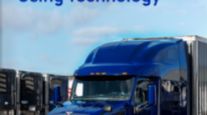iTECH: Yard Management Systems Enable Carriers to Raise Their Trailer Productivity
By Stephen Bennett, Contributing Writer
This story appears in the August/September 2013 issue of iTECH, published in the Aug. 5 print edition of Transport Topics. Click here to subscribe today.
Yard-management systems at large manufacturing plants, distribution centers or retailers’ warehouses can benefit the motor carriers serving those facilities by returning trailers to service quickly, improving overall equipment utilization and fleet productivity, users and vendors of yard systems said.
“At a click of the mouse I can see how many trailers I have at a given facility and which are loaded and which are empty,” said James Bagwell, executive vice president of MLI/ILG, a Buford, Ga., logistics services provider that owns and operates about 110 tractors and some 200 trailers.
The company also brokers loads to other carriers when it needs additional capacity. “Our carrier partners also have that same visibility specific to their equipment,” Bagwell said.
MLI/ILG uses a Web-based yard-management system, YardTrac, provided by New York-based Exotrac. The system relies on bar code stickers attached to trailers. Yard workers scan the bar code and record the location of the trailer, using handheld units with built-in GPS. That information is transmitted via cellular service to the yard-management system and presented on a website. Information on the status of trailers — their location, whether they are full or empty — appears in a color-coded graphic rendering of the yard. Empty trailers are indicated in green, while trailers being loaded appear in red.
Partner carriers with dropped trailers in the yard have passwords for limited access to the website so they can check on the status of their trailers. “It allows them to see that they have five trailers on the yard at this site and four of them are empty,” Bagwell said.
Daimler Trucks North America, based in Portland, Ore., is using a yard-management system at its plant in Saltillo, Mexico, that relies on radio frequency identification tags magnetically attached to trailers. The RFID tags enable the truck manufacturer to track the location and contents of the trailers, and to direct yard truck drivers to a specific trailer when it needs to be moved.
Roderick Flores, DTNA’s information technology project manager, vehicle electronics operations and corporate support, said in an e-mail that an employee doing check-ins and check-outs at the facility’s gate enters trailer information using a desktop computer. The computer, connected to an RFID reader/antenna, associates the RFID tag with the trailer.
When an empty trailer leaves the property, the tag is again interrogated by the fixed reader, and the gatekeeper removes the tag before the trailer leaves the yard, Flores said. Stacks of tags are kept in a bin at the gate and reused for subsequent incoming trailers.
The DTNA plant in Saltillo, which produces Freightliner Cascadia tractors, began using Yard Hound, the system provided by PINC Solutions, in March. Now the OEM is implementing the yard-management system at another manufacturing plant in Mexico and four plants in the United States. Further implementation at the manufacturer’s parts distribution centers as well as other DTNA locations “has been discussed,” Flores said, “but this effort will only kick off after the deployments at the remaining truck manufacturing plants are completed.”
Yard-management systems have evolved over the years, vendors said. Instead of installing antennae and related wiring for Wi-Fi coverage of a yard, and installing licensed software on users’ computers, some vendors now offer systems that rely on cellular transmission and “software as a service,” a distribution model in which applications are hosted by a vendor or service provider and are made available to customers over the Internet. It also is referred to as “cloud computing.”
“We don’t have to load the pro¬gram locally anymore on the machine,” said Nate Harris, president of Cypress Inland Corp., a company in Castle Rock, Colo., that markets a system called YardView. “It’s all in the cloud. If we’re going to make changes, it’s seamless — people just suddenly see a change the next day.”
Aleks Gollu, chief technology officer for PINC, based in Alameda, Calif., said that cellular broadband “was not reliable enough” when the company started offering its system about 10 years ago, so it installed Wi-Fi infrastructure in customers’ yards. That has changed, Gollu said. “The cellular broadband — 3G and 4G — now are reliable enough that almost all of our yard trucks are connected to our hosting infrastructure via cellular broadband coverage,” he said. “We haven’t in-stalled Wi-Fi since 2011.”
Global positioning technology also had improved, vendors said, enabling yard-management systems to more accurately determine the location of each trailer. At the DTNA Saltillo plant, each yard truck is outfitted with a ruggedized tablet computer, a 4G cellular transmitter, an antenna/RFID reader and a GPS unit. As a yard truck moves about the yard, the automated reader takes readings at 10-second intervals of all tags within a range of about 30 feet, and the cellular transmitter sends updated information to PINC’s server, Gollu said.
The yard of a distribution center tends to be overlooked or given short shrift in trucking, Gollu and other vendors said. Gollu noted that carriers often use a fleet-management system or a mobile resource management system to manage their fleet and drivers over the road; warehouse operators use warehouse-management systems to manage inventory; and shippers use transportation-management systems to plan shipments. Yard-management technology acts “as a glue that connects all of this together,” Gollu said, by show¬ing how many empty trailers are in a yard, the dock doors they should be moved to, when to start loading, and the technology lets carriers see when their trailers are going to be ready for pickup.
“It used to be that all of this would be coordinated with phone and faxes,” Gollu said. “It then moved into [electronic data interchange].” A drawback of EDI, Gollu said, is “that data is not always there, and it typically arrives with a 24-hour delay because the information is transmitted in batch mode” — stored up and sent at intervals.
Web-based yard management marks an improvement, Gollu said, because it provides a portal where all players, including carriers, are able to share “real-time” data about shipments and trailers.
That can include notifying carriers when one of their trailers is damaged, said Jon Donchey, chief operating officer of Exotrac. The handhelds that yard workers use also have photograph capability, so that an image of a damaged trailer can be in notifications to carriers, telling them, for example, that a damaged trailer is in “hold status” and cannot be used.
The size of a yard can dictate the choice of yard-management system, some vendors said.
Zebra Technologies Corp. of Vernon Hills, Ill., markets a yard-management system that features battery-powered RFID tags designed to be read over a long range, the company said. The system’s fixed-tag sensors can be spaced up to 300 feet apart, said Steve Raymond, Zebra’s vice president of consulting services. That’s a consideration in a big, busy yard, Raymond said, because it allows operators to install the sensors “up high, out of harm’s way, while minimizing infrastructure.”
ES3, a company that manages a grocery distribution network with warehouses in York, Pa., and elsewhere uses the Zebra system to manage its trailers and those belonging to other carriers.
The yard at the York facility holds an average of 1,350 trailers and sometimes more than 1,600, said Anthony Bomysoad, who manages yard operations there for ES3. More than 40 yard jockeys handle trailer moves to more than 170 dock doors.
“We perform, on average, 1,750 trailer moves and have maxed out at 2,011 trailer moves in a 24-hour period,” Bomysoad said in an e-mail.
“Locating trailers on the yard would be the biggest challenge we face,” Bomysoad said. “Having an active RFID locating system helps us keep track of each load as it enters the facility. The second-largest challenge we face is the reporting and recording of trailers as they enter and exit the campus.”
With the yard-management system, he said, “We are able to track every update as the trailer moves throughout the yard, thus tracking every movement in our system and storing it in our database for later use.”
Improved control of a yard — knowing where trailers are — means less “roaming the aisles looking for trailers so there’s less congestion,” Zebra’s Raymond said.




